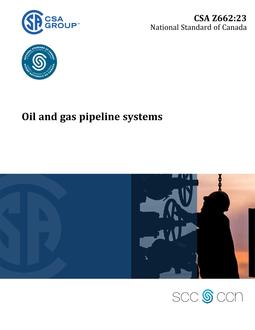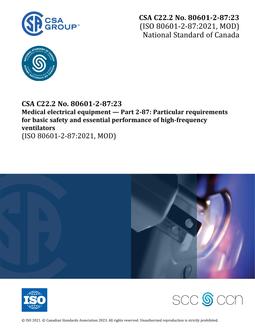
CSA Z662:23
Thanks to the financial contribution of the Western Regulators Forum (WRF), CSA Group is providing the CSA Petroleum and Natural Gas standards in a downloadable PDF format for no fee to Canadian customers only (Click for more detail). If you are not in Canada, please reach out to one of the following licensed CSA Group resellers to purchase these standards or contact your local reseller:
• Accuris (formerly S&P Global) (https://global.ihs.com/)
• Techstreet (https://www.techstreet.com/)
Preface
This is the ninth edition of CSA Z662, Oil and gas pipeline systems. It supersedes the previous editions published in 2019, 2015, 2011, 2007, 2003, 1999, 1996, and 1994.
The following are the significant changes to this edition:
a) Clause 3and Annex Ahave been revised to provide a common framework for audits;
b) Clauses 4and 7have been revised to address concerns with gross girth weld strength under-matching and heat affected zone softening, when welding high strength line pipe for a stress based design pipeline;
c) Clause 17, on composite reinforced steel pipelines, has been deleted. A new Clause 17, on hydrogen and hydrogen blend pipeline systems, has been added.
d) For hydrogen and renewable gas:
i) the scope has been updated to
1) confirm hydrogen and hydrogen blends are included in the standard;
2) confirm that renewable gas is equivalent to wellsite produced gas; and
3) clarify that other gas sources and processes, not just wellsites, can produce hydrogen and renewable gas;
ii) a new Clause 17had been added to formally integrate hydrogen requirements into this Standard; and
iii) changes have been made throughout this Standard to aid with handling unique design,
material, construction, and operational requirements for pipelines containing hydrogen.
e) For safety class:
i) changes have been made in Clauses 4and 10to permit pressure design in accordance with Annex C;
ii) Annex Chas been revised to include a safety class designation approach for a selection of service fluids. Where Annex Cis used for pressure design, safety class is used instead of class location, as a basis for defining the maximum allowable hoop stress;
iii) Annex Chas been revised to include a table that maps the safety class determined according to the Annex onto a class location. The class location derived from this table is used as a basis for identifying the applicable requirements in all other class-location-dependent clauses of this Standard.
f) Clause 7.7.4.3and Table 7.4have been revised to allow the use of volumetric NDE to replace nick breaks for welding procedure qualification and welder qualification and expand the allowable limits of porosity in nick breaks;
g) New content has been added to Clause 10provide more clarity for the necessary right-of way activities to continuously address potential hazards to the pipeline system.
h) Clause 12.5.7has been aligned to Clause 5.7.1in regard to a more prescriptive requirement for records retention to include retention of material test reports for all steel pipe and components.
i) Additional content has been added to Clause 12to address cross bore mitigation.
j) Annex B has been revised to include more detailed requirements for performing a risk assessment and quantitative acceptance criteria for safety and environmental risks.
k) Annex N has been revised to align with the Annex B revisions.
l) Revisions have been made to the requirements for the design pressure and design wall thickness of field cold bends made from steel pipe, where the longitudinal axis is not deflected more than 1.5° in any length along the axis equal to the outside diameter of the pipe.
m) A new requirement has been introduced to obtain and retain material test reports for pipe and components.
n) Requirements have been expanded for threaded or welded auxiliary connections on blind flanges of various sizes.
o) Additional limitations have been imposed on ASTM A105/A105M flanges.
p) New requirements have been introduced for induction and cold bends through reference to specifications in CSA Z245.16 and Z245.17.
q) New requalification requirements have been introduced for coated pipe in extended storage.
r) New requirements have been introduced for hydrovac or air-vac operations.
s) Requirements have been updated for fluids containing H2S.
t) Requirements have been updated for cyclic pressure in reinforced composite pipelines, and new requirements for pulsation dampeners.
u) New requirements have been introduced for use of reinforced composite pipe in gas transmission service.
v) New requirement has been added for certain transition pieces to be registered as per CSA B51.
w) Requirements have been updated for the repair of defects in polyethylene pipe prior to and during installation.
x) Requirements have been updated for materials for elevated temperature service pipelines.
y) New requirements have been introduced to address effect of liquid hydrocarbons in pipe wall on heat fusion joining of PE pipe (in other than gas distribution service).
z) Requirements have been revised for PE pipe pressure testing (in other than gas distribution service).
aa) Requirements have been included for corrosion resistant alloy risers and interconnecting piping for lined pipelines and polyethylene pipelines
ab) Requirements have been updated for sour service pipelines to ensure that Clause 16will be consistent with the next version of MR0175/ISO15156.
The requirements of this Standard are considered to be adequate under conditions normally encountered in the oil and natural gas industry. Specific requirements for abnormal or unusual conditions are not prescribed, nor are all details related to engineering and construction prescribed. It is intended that all work performed within the scope of this Standard meet the standards of safety and integrity expressed or implied herein, and that the requirements of this
Standard be applied with due regard to the protection of the environment, which includes land, water, plant life, and animal life. Detailed requirements concerning the protection of the environment are not prescribed.
It is expected that changes will be made from time to time, based on new experience and technology. Where necessary, amendments and supplements will be prepared by the Technical Committee and published in accordance with CSA Group practices.
CSA Group acknowledges that the development of this Standard was made possible, in part, by the financial support of Natural Resources Canada.
This Standard was prepared by the Technical Committee on Petroleum and Natural Gas Industry Pipeline Systems and Materials, under the jurisdiction of the Strategic Steering Committee on Petroleum and Natural Gas Industry Systems, and has been formally approved by the Technical Committee.
This Standard has been developed in compliance with Standards Council of Canada requirements for National Standards of Canada. It has been published as a National Standard of Canada by CSA Group.
Scope
1.1
This Standard covers the design, construction, operation, maintenance, deactivation, and abandonment of oil and gas industry pipeline systems that convey
a) liquid hydrocarbons, including crude oil, multiphase fluids, condensate, liquid petroleum products, natural gas liquids, and liquefied petroleum gas;
b) oilfield water;
c) oilfield steam;
d) liquid or dense phase carbon dioxide; or
e) gas.
Notes:
1) Vapour phase carbon dioxide and hydrogen pipeline systems fall under Item e).
2) Designers are cautioned that the requirements in this Standard might not be appropriate for gases other than natural gas, manufactured gas, vapour phase carbon dioxide, hydrogen, and synthetic gas.
1.2
The scope of this Standard, as shown in Figures 1.1 and 1.2, includes
a) for oil industry fluids, piping and equipment in offshore pipelines, onshore pipelines, tank farms, pump stations, pressure-regulating stations, and measuring stations;
b) oil pump stations, pipeline tank farms, and pipeline terminals;
c) pipe-type storage vessels;
d) carbon dioxide pipelines;
e) for gas industry fluids, piping and equipment in offshore pipelines, onshore pipelines, compressor stations, measuring stations, hydrogen blending facilities, and pressure-regulating stations;
f) gas compressor stations; and
g) gas storage lines and pipe-type and bottle-type gas storage vessels.
Notes:
1) Gas industry fluids from renewable natural gas (RNG) and other production facilities are included in Item e).
2) Measuring and pressure-regulating stations that include blended gas industry fluids are included in Item e).
1.3
This Standard does not apply to
a) piping with metal temperatures below –70 °C;
b) gas piping beyond the outlet of the customer’s meter set assembly (covered by CSA B149.1);
c) piping in natural gas liquids extraction plants, gas processing plants (except main gas stream piping in dehydration and all other processing plants installed as part of gas pipeline systems), gas manufacturing plants, industrial plants, and mines;
d) oil refineries, terminals other than pipeline terminals, and marketing bulk plants;
e) abandoned piping;
f) in-plant piping for drinking, make-up, or boiler feed water;
g) casing, tubing, or pipe in oil or gas wells, wellheads, separators, production tanks, and other production facilities;
h) vent piping for waste gases of any kind operating at or near atmospheric pressure;
i) heat exchangers;
j) liquefied natural gas systems (covered by CSA Z276);
k) liquid fuel distribution systems;
l) loading/unloading facilities for tankers or barges;
m) refuelling facilities;
n) hydrocarbon storage in underground formations and associated equipment (covered by CSA Z341 Series);
o) RNG, biogas, and synthetic gas production facilities; and
p) hydrogen gas production facilities.
1.4
This Standard is intended to establish essential requirements and minimum standards for the design, construction, operation, pipeline system management, and abandonment of oil and gas industry pipeline systems. This Standard is not an application manual for these activities. It is intended to be used by persons competent to make technical judgments in the areas to which this Standard is being applied including engineering, safety, and environmental protection.
Note: Where newly developed materials or processes are used, or unusual conditions are encountered, requirements in addition to those specified in this Standard might be needed.
1.5
The requirements of this Standard are applicable to the operation, maintenance, and upgrading of existing installations. It is not intended that such requirements be applied retroactively to existing installations insofar as design, materials, construction, and established operating pressures are concerned, except as required by Clause 10.7.1 for changes in class location and Clause 10.8.1 for crossings of existing pipelines.
1.6
Unless otherwise stated, to determine conformance with the specified requirements, it is intended that observed or calculated values be rounded to the nearest unit in the last right hand place of figures used in expressing the limiting value, in accordance with the rounding method of ASTM E29.
1.7
Where any requirements of this Standard are at variance with the requirements of other publications referenced in this Standard, it is intended that the requirements of this Standard govern.
1.8
It is not the intent of this Standard to prevent the development of new equipment or practices, or to prescribe how such innovations are to be handled.
1.9
In this Standard, “shall” is used to express a requirement, i.e., a provision that the user is obliged to satisfy in order to comply with the Standard; “should” is used to express a recommendation or that which is advised but not required; and “may” is used to express an option or that which is permissible within the limits of the Standard.
Notes accompanying clauses do not include requirements or alternative requirements; the purpose of a note accompanying a clause is to separate from the text explanatory or informative material.
Notes to tables and figures are considered part of the table or figure and may be written as requirements.
Annexes are designated normative (mandatory) or informative (non-mandatory) to define their application.
Product Details
- Edition:
- 9th
- Published:
- 06/30/2023
- ISBN(s):
- 9781488345678
- Number of Pages:
- 1001
- File Size:
- 1 file , 11 MB
- Product Code(s):
- 2430394, 2430394
- Note:
- This product is unavailable in Russia, Ukraine, Belarus


